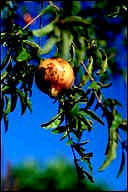Three pomegranates can be seen on the silver shekel of Jerusalem, the coin mentioned
in the Bible. It was in circulation from 143 to 135 BC. Hiram of Tyre used the pomegranate
in building Solomon's temple (I Kings 7:18, 20). It is also mentioned in regards to the
ephod of the high priest which was bordered at the hem with pomegranates.
The medicinal powers of the pomegranate are mentioned in Greek mythology. It is said
that Persephone becomes betrothed to her kidnapper, Hades, king of the underworld,
after eating pomegranate seeds. Chinese mention pomegranate juice as a longevity
drug.
But the pomegranate, whose whose main attraction has been as a fruit, is now coming
into its own as a modern medical resource. Two separate Israeli medical research
groups, are developing a broad range of treatments and products derived from the fruit;
At the Lipid Research Laboratory of Haifa's Rambam Medical Center, Dr. Michael Aviram,
a Technion biochemist, for 20 years has researched ways to prevent and break down
the deposits of cholesterol in the arteries -- arteriosclerosis -- that cause strokes and
heart disease. Searching for natural antioxidants, he says he tested "many different
substances before focusing on the pomegranate". Its juice, he found, contains a
particularly powerful antioxidant, a flavonoid, more effective at fighting heart disease
than those known in tomatoes and red wine.
For the past year, he has tested the medicinal value of the juice by providing it to
Rambam patients suffering from carotid artery stenosis, a narrowing of those arteries
that bring blood to the brain. The results, he reports, have been rapid with improvements
noticed as early as after the first month.
The potential exists, Aviram says, for high-risk patients to be spared bypass surgery
simply by drinking pomegranate juice. To make the consumption of pomegranate more
palatable, he is working on developing a pill with the same medicinal attributes as the
concentrated liquid.
Dr. Ephraim Lansky, the founder of the Rimonest company, is even more upbeat on the
prospects for pomegranate. He suggests that research may prove the pomegranate is
a virtual cure-all. Its juice, flesh, and even its skin, he believes, contain properties to
counter not only cholesterol, but aging, and perhaps even cancer and AIDS, as well....
The primary shareholder and head researcher of Rimonest, Lansky is a University of
Pennsylvania-trained physician, with a doctorate in psychology and biology. He is
qualified as a homeopathic physician and acupuncturist. He's currently marketing
Cardiogranate, a juice concentrate which he says combats high cholesterol. He is also
developing a cosmetic line of anti-aging creams, massage oils, masques and toners,
using estrogen-rich extractions from pomegranate seeds and peel. As a practicing
homeopathic professional, he prescribes pomegranate juice for fever and gives it to
menopausal women for hot flashes.
Dr. Lansky is about to begin tests on mice in Israel's Beilinson Hospital and the
Anderson Cancer Center in Houston, Texas, in order to confirm the efficacy of
pomegranate in counteracting the proliferation of human breast-cancer cells.
 Because of its many seeds, the pomegranate has long stood as a symbol for fertility. A
refreshing delicacy, it is loved by those who dwell in hot, thirsty lands. The plant grows
wild in Syria and Persia and is cultivated in Israel, where 3,000 tons a year are grown
annually. It is a shrub or small tree that can grow as high as fifteen feet, with a straight
stem, reddish bark and plenty of spreading branches. The dark green leaves are highly
polished and the pomegranate flowers are red. When ripe, the fruit is about the size of an
orange, has a thick maroon jacket enveloping the pulp. Syrup made from the
pomegranate seeds is known as grenadine. The first sherbet was made from snow
mixed with pomegranate juice. In ancient times pharmacists made an astringent
medication for treatment of dysentery from the blossoms.
Because of its many seeds, the pomegranate has long stood as a symbol for fertility. A
refreshing delicacy, it is loved by those who dwell in hot, thirsty lands. The plant grows
wild in Syria and Persia and is cultivated in Israel, where 3,000 tons a year are grown
annually. It is a shrub or small tree that can grow as high as fifteen feet, with a straight
stem, reddish bark and plenty of spreading branches. The dark green leaves are highly
polished and the pomegranate flowers are red. When ripe, the fruit is about the size of an
orange, has a thick maroon jacket enveloping the pulp. Syrup made from the
pomegranate seeds is known as grenadine. The first sherbet was made from snow
mixed with pomegranate juice. In ancient times pharmacists made an astringent
medication for treatment of dysentery from the blossoms.